The Inner Hebrides are a collection of islands off the west coast of Scotland, including Skye, Raasay, the Small Isles (Rum, Eigg, Muck and Canna), Mull and Iona, Lismore, Colonsay, Coll, Tiree, Islay and Jura.
The largest and most northerly of these is the Isle of Skye. Skye and neighbouring Isle of Raasay are covered in our Guide to Skye.
Getting there
By ferry
Caledonain MacBrayne from Mallaig to the Small Isles. See our Guide to Mallaig on the West Highland Line.
These passenger only sailings are provided by Caledonian MacBrayne with their vessel MV Lochnevis. The ferry service runs from Mallaig to a selection of these islands daily so for overnight stays a calendar will be as useful as a watch to known when to catch the ferry home!
Arisaig Marine Ltd from Arisaig to the Small Isles. See our Guide to Arisaig on the West Highland Line.
From April to September it is possible to catch a passenger ferry from Arisaig to the islands of Eigg, Muck, and Rum, as well as Sunday trips to Canna.
The Islands
These islands have all had purpose built piers installed ending the practice of passengers (and cargo!) going ashore by ‘flitboat’. These small boats came out to meet the ferry with passengers transferring at sea to get ashore. The islands are remote and sparsely inhabited. Each offers something quite unique to the visitor.
Rum
Rum is by far the largest island and with its jagged volcanic mountains, is a distinctive feature of the west coast. The Island is an important nature reserve with otter, sea eagle and a unique mountaintop colony of Manx shearwaters.
Also on the Island is the remarkable Kinloch Castle, a derelict, publicly-owned former hunting lodge which is currently for sale.
The Island is covered in tracks and small trails making it ideal for exploring on foot or bike. See Isle of Rum for more details.
Eigg
Eigg is a community island which is now owned by the inhabitants of the Island. See Isle of Eigg for more details.
The main geological feature is a huge basalt plateau 1000 feet above sea level, and a great stump of columnar pitchstone lava, known as An Sgurr, rising out of the plateau another 290 feet. This gives the Island its distinct shape.
Muck
Muck is the smallest of the isles and is famous for its sandy beaches, rocky shores and the 452 feet Beinn Airein, with its panoramic view of the surrounding islands. See Isle of Muck for more details.
Canna
Finally Canna is the small five miles long island which is managed by the National Trust for Scotland and has a population of around 15. For total escapism to just enjoy the views and walk, this is the ideal location.
Look out for the high basalt cliffs and compass hill, which has such a high metal content that it will distort a compass. The island is home to large colonies of seabirds, including shags, puffins, razorbills and black guillemots.
See National Trust for Scotland and Isle of Canna for more details.
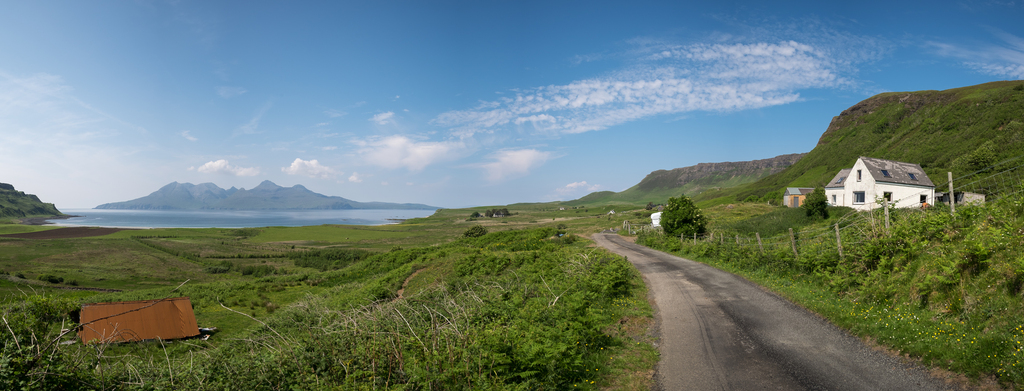
From Eigg to Rum
Photo credit: “From Eigg to Rum” by Mark, CC BY-SA 2.0
Getting there by ferry
Caledonian MacBrayne from Oban to Mull. See our Guide to Oban on the West Highland Line.
Caledonian MacBrayne from Mull to Iona
Getting around
West Coast Motors run the island’s bus service.
Isle of Mull
From the pier at Oban railway station, catch the Caledonian MacBrayne ferry for the short 45 minute journey to the Isle of Mull, arriving at Craignure.
This short crossing has one of the largest and best appointed ships in the CalMac fleet. There are up to 10 sailings daily in each direction of which some are rail connected, although the others may also be useful to rail passengers if staying in Oban.
When on Mull, take time to explore the island. The mountains that stretch across the middle of the island rise to over 900 metres and are particularly popular with hillwalkers. Mountain ranges in the south and the east are pierced by glens and waterfalls.
The island’s main town of Tobermory is the setting of the CBeebies series, 'Balamory'. As a result, it has become the top holiday destination for kids desperate to see the colourful houses where PC Plum and Suzie Sweet live.
Tobermory can be reached by a 45 minute bus journey from Craignure ferry terminal (see West Coast Motors services 95, 495).
Tobermory Distillery, founded in 1798, produces single malt whiskies including Tobermory and Ledaig ranges, and Tobermory Gin. Water comes from the nearby Gearr Abhainn brook. They offer various tours and tastings.
Mull is home to a wide range of wildlife and is one of best places in Europe to see the golden eagle and white tailed sea eagle. It also offers a home to the elusive European otter. Organised whale and dolphin watching trips, on which minke whales and dolphins among others can be seen, are available on the Island. See Tobermory Isle of Mull for more details.
Alternatively, travel by bus for 1 hour 20 mins from Craignure to Fionnphort ferry terminal to visit the Island of Iona (see West Coast Motors services 96, 496).
Iona is often referred to as ‘The Cradle of Christianity in Scotland’ as it was here that Columba first landed after being banished from Ireland in 563AD. Once settled on the island, Columba and his followers built a wooden monastery.
This was later replaced with stone when the monastery was turned into a Benedictine Abbey around 1200. Today Iona Abbey has been fully restored.
The highest point of the island is Dun I at 323 feet and commands wonderful panoramic views towards Mull, Staffa and beyond. The 10 minute ferry to Iona is on the MV Loch Buie. As it is a small island it is best explored on foot.
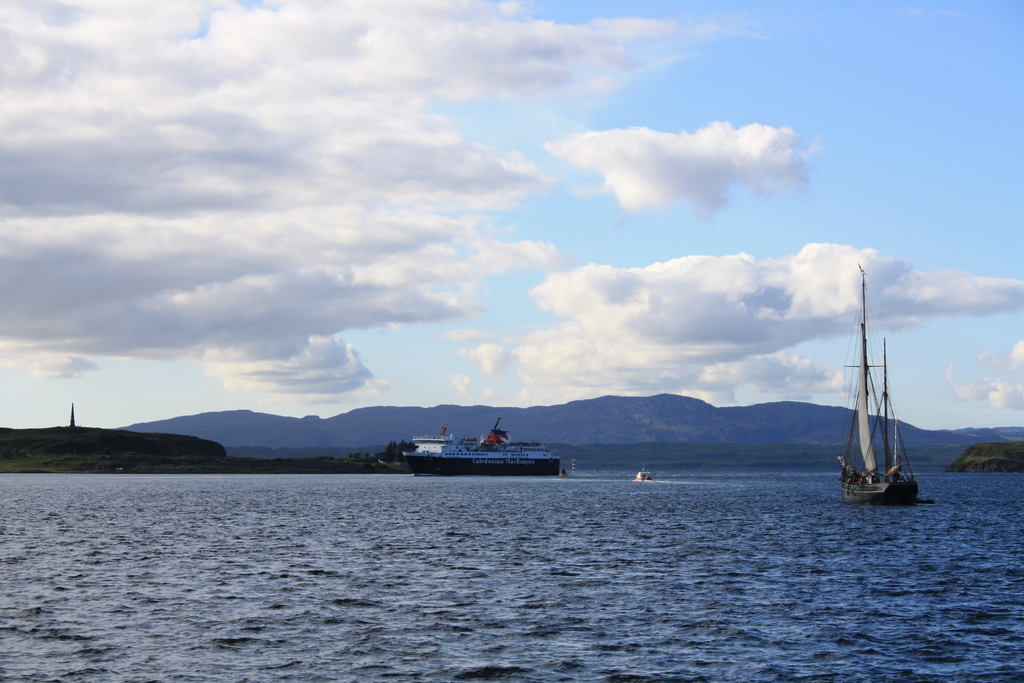
MV Isle of Mull ferry to Mull
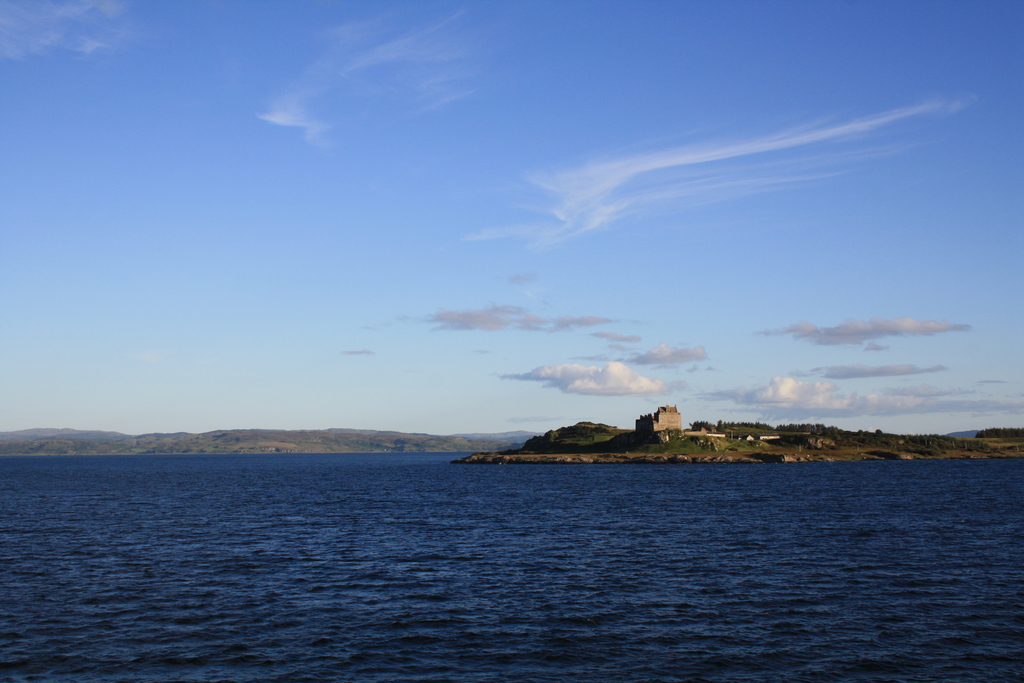
Duart Castle, Mull
Getting there by ferry
Caledonian MacBrayne from Oban to Lismore. See our Guide to Oban on the West Highland Line.
Ferries to Lismore use either the MV Loch Striven or MV Loch Riddon. The crossing time is fifty minutes and there are usually four sailings per day in each direction.
Lismore has a tranquil, rolling landscape and is ideal for cyclists. The main village of Achnacroish lies halfway along the island’s eastern coast. As well as having the shop and the school, the village is the terminal for the main ferry service from Oban.
The highest point on the island is the hill at the southern end known as Barr Mòr – at just short of 130m high, the views from this low summit are unforgettable.
There are several popular walks on Lismore from the ferry’s arrival point. One popular walk is to Achadun Castle (also known as Achanduin Castle), which was once the residence of the Bishops of Argyll. There is very little remaining of the Castle but the views, as all parts of the Island are amazing.
There is also a four hour walk to two of the island’s best known archaeological features, Tirefour Broch and Castle Coeffin.
Find out more at the island’s own community website Isle of Lismore. All parts of the island may be explored by foot or bike from the ferry terminal at Achnacroish.
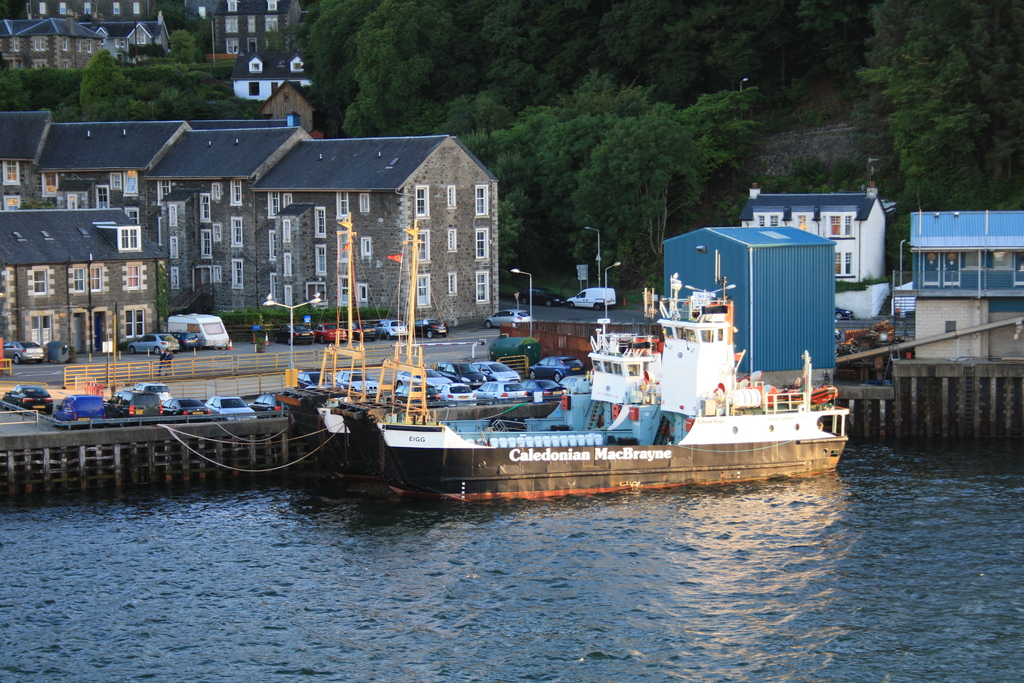
MV Eigg to Lismore (not Eigg!)
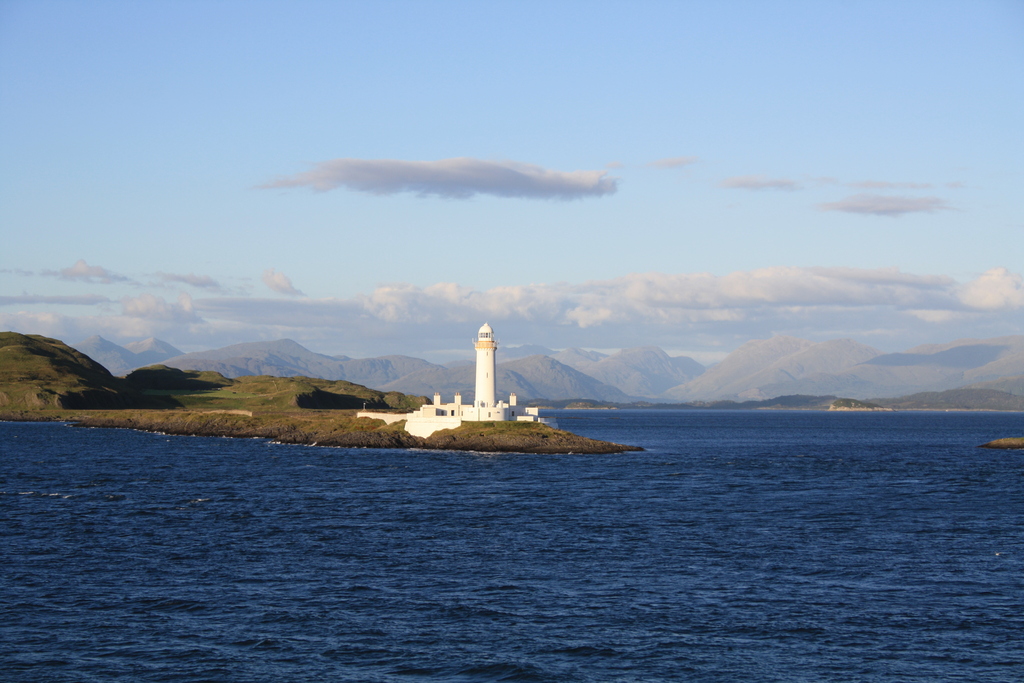
Lismore lighthouse
Getting there by ferry
Caledonian MacBrayne from Oban to Colonsay. See our Guide to Oban on the West Highland Line.
The ferry journey from Oban to Colonsay takes 2 hours 30 mins. There is a departure most days (fewer in winter) from Oban, at various times.
Caledonian MacBrayne from Islay to Colonsay. The ferry journey from Islay to Colonsay takes 1 hour.
By plane
Colonsay Airfield from Oban. Oban Airport is located in Connel. See our Guide to Connel on the West Highland Line.
Colonsay is an ideal place for those with an interest in archaeology as artefacts dating back to the Stone Age have been found here. There are also many historical ruins and ecclesiastical relics on the island.
It is, however, for the natural beauty that most people come here. There are numerous beaches throughout the island and impressive cliffs on the west coast. The island is also noted for the diversity of its wild flowers with more than 400 species recorded.
The island is easily explored by foot or bike and has its own website at Colonsay.
Is it also possible to take the Caledonian MacBrayne ferry between Colonsay and Islay. The ferry journey takes 1 hour. Islay is the most southerly island of the Inner Hebrides and is packed with whisky distilleries. See Islay Info for more details.
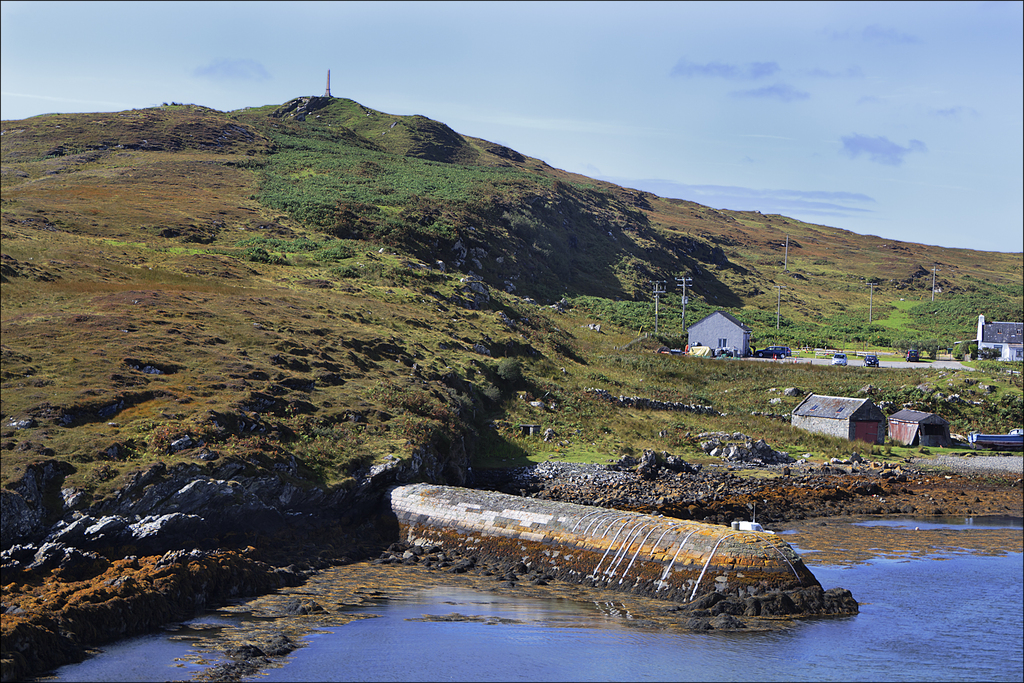
Colonsay
Photo credit: “Colonsay” by dun_deagh, CC BY-SA 2.0
Getting there by ferry
Caledonian MacBrayne from Oban to Coll and Tiree. See our Guide to Oban on the West Highland Line.
The ferry journey takes just under three hours from Oban to Coll and four hours to Tiree. The ship takes a route past Mull and then through the Sound of Mull, a long strip of sea between the Isle of Mull and the mainland which is particularly scenic.
It then heads out into open waters for the main part of the crossing. Services go to both islands most days during summer but with a reduced service during winter.
By plane
Coll Airport from Oban. Oban Airport is located in Connel. See our Guide to Connel on the West Highland Line.
Tiree Airport from Glasgow and Oban. Oban Airport is located in Connel. See our Guide to Connel on the West Highland Line.
Coll
The low-lying Island of Coll is characterised by its landscape of sandy beaches, sand dunes and freshwater lochs. The Island’s only village is the quiet, fishing village of Arinagour.
There is a population of 150. It’s the perfect place for those wishing to escape modern life and do nothing more strenuous than walk the Island’s beaches or discover the local flora and fauna.
In summer particularly, the sound of skylarks, the fragrance of the flowers and the views of distant shimmering islands make this a very special place.
From May to August, Coll’s Royal Society for the Protection of Birds (RSPB) reserve plays a crucial role in the protection of the corncrake, a bird that is globally endangered but one of the rarest and fastest declining in the UK due to intensive agricultural methods.
On this reserve, and throughout the islands, the RSPB encourage corncrake-friendly farming methods. However, the corncrake is just one of many species found on the island – the opportunity to see redshanks, lapwing, snipe and in winter, barnacle and Greenland white-fronted geese make this an ornithologist’s paradise.
And it’s not just a place for nature lovers. Those interested in the islands heritage will be fascinated by Coll’s iron-age forts, crannogs (an ancient type of loch side house) and ‘Na Sgeulachan’ (Teller of Tales) standing stones.
The island is 13 miles long in total and may be explored by foot or bike. See Visit Coll for more details.
Tiree
Tiree is southwest of Coll and is more populated, with 650 inhabitants. Scarinish, the main village on Tiree, houses shops and a hotel as well as providing the ferry terminal for the island.
On the west of the island is the Isle of Tiree Distillery. Founded in 2012, it produces single malt whisky, single grain whisky, and gin. Ingredients for their gin include kelp from the Atlantic Ocean and locally sourced botanicals.
They offer a Distillery Tour (1 hour). This is Tiree's first legal distillery since the 1800s (distilling was illegal on the island from 1802 to 1950).
The coastline of Tiree is a mixture of rocky outcrops and long stretches of white sandy beach which, along with the uninterrupted Atlantic winds, makes Tiree a perfect place for windsurfing.
See Isle of Tiree for more details.
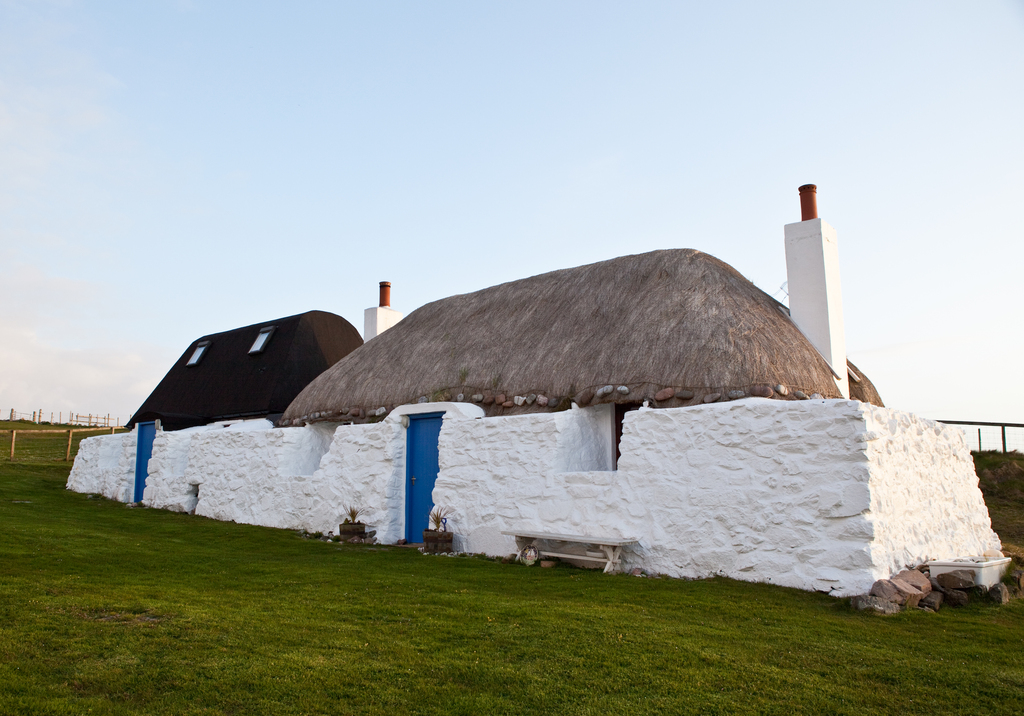
Tiree Cottages
Photo credit: “Tiree Cottages” by Nick Jewell, CC BY 2.0
Page last updated 21 October 2025